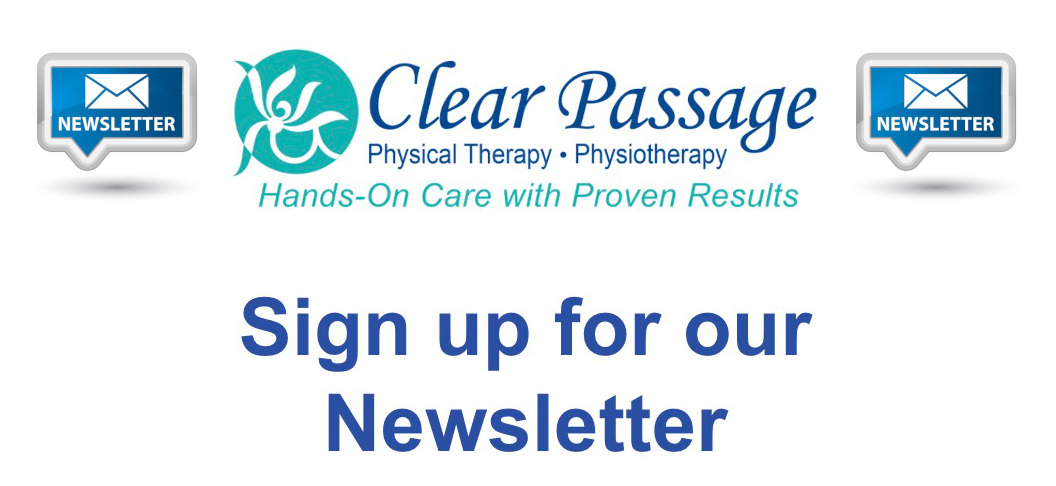 Yearning for pregnancy—and being unable to achieve it after dedicated periods of trying—can cause a woman great psychological and emotional pain.
Yearning for pregnancy—and being unable to achieve it after dedicated periods of trying—can cause a woman great psychological and emotional pain.
Let’s jump into what your options are and why out of all of them, the Wurn Technique is your healthiest, cost-conscious, and most effective option.
What is Infertility?
According to the American College of Obstetricians and Gynecologists (ACOG), the definition of female infertility is being unable to conceive after twelve months of trying in a woman younger than age 35 and after six months in a woman age 35 or older. Female infertility is a common medical condition that affects women of all childbearing ages and medical backgrounds, and it often takes women by surprise. The ACOG estimates that up to 15 percent of couples will experience infertility.
Although it can feel discouraging, receiving a diagnosis of infertility is often just the first step in the conception journey for many women. Once a woman has been diagnosed infertile, her gynecologist or healthcare provider can begin to uncover the factors contributing to her infertility, and her potential treatment options can be examined.
Traditional infertility treatment options
Some women are familiar with many of the myriad infertility treatment options available today, including pharmaceutical hormones and surgery. In particularly challenging cases, your gynecologist may suggest so-called Assisted Reproductive technique (ART) procedures such as in vitro fertilization (IVF). While these treatments can increase a woman’s chances of achieving a pregnancy, many women are averse to taking strong hormone medications, concerned with short or long-term side effects.
In some cases, the surgery can prevent your ability to ever achieve pregnancy independently without intimidating and expensive assistive technologies that can also carry a low success rate.
Many women don’t realize a natural treatment option is available for one of the most common causes of infertility, tubal factor infertility (generally blocked fallopian tubes.)
This natural alternative treatment option is the Clear Passage® Approach (CPA). It is a manual physical therapy program that has been scientifically shown to be safe and effective while still being non-invasive and non-surgical.
An increasing body of scientific research also backs this manual physical therapy. It has been linked to a relatively high pregnancy rate compared to surgery and IVF while simultaneously helping many women with blocked fallopian tubes achieve a natural pregnancy.
Read on to learn more about how manual physical therapy via the CPA can successfully open a totally blocked fallopian tube and return its function—including fertility lost due to the blockage. You will also learn how researchers uncover other surprising ways that manual physical therapy can improve a woman’s fertility.
Some terms to know?
- Tubal Factor Infertility
- Adhesions (Internal Scarring)
What is tubal factor infertility? How does it work? What does it mean for me?
Before delving into how a manual physical therapy known as the Clear Passage Approach or Wurn Technique became a scientifically validated treatment for female infertility, it’s critical to understand one of the primary causes.
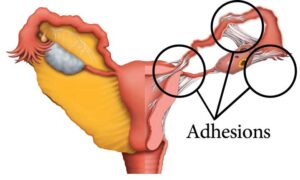
Blocked fallopian tubes, also known as tubal factor infertility, or tubal infertility, are one of the primary causes of female infertility, accounting for 25 to 35 percent of all cases of female infertility, according to the American Society of Reproductive Medicine (ASRM).
When women embark on a conception journey, they quickly realize that specific medical terms come up time and time again.
One of these terms is “tubal factor infertility,”— essentially one or two blocked fallopian tubes, a condition that prevents conception.
Two fallopian tubes connect a woman’s ovaries to her uterus. These hollow structures are the enclosed path through which a woman’s egg cell should begin its journey toward the uterus and through which one or more sperm cells swim up toward the egg. Natural fertilization occurs when sperm meets the egg within the fallopian tube. Thus, this tiny organ is truly where human life is born.
After this occurs, the fertilized embryo continues the journey begun by the egg, down toward the uterus for implantation. An ectopic pregnancy will happen if the embryo becomes stuck in the tube by adhesions. In this case, the embryo will not survive, and the mother’s health is at significant risk until an injection of methotrexate destroys the embryo. If not given quickly enough, surgical excision of the embryo is generally required, a condition that generally destroys that tube.
Adhesions are naturally occurring glue-like bonds that can form outside or within the tube, creating a partially or entirely blocked organ. These can kink a tube like a garden hose or stop it up from the inside.
Sperm and egg can never meet in a tube that adhesions have blocked, so fertilization can never occur naturally.
What are adhesions, and where do adhesions come from?
It makes intuitive sense that an egg cell, sperm cell, or fertilized embryo cannot complete its critical journey through a fallopian tube that adhesions have blocked—but what are adhesions in the first place?
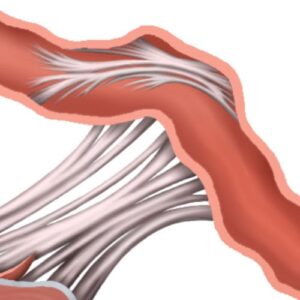
According to the National Institutes of Health (NIH), adhesions are band-like tissues that can cause organs to stick together instead of sliding against one another. This glue-like binding can bind organs to other structures or squeeze them like a straitjacket, causing pain or dysfunction such as female infertility.
It’s helpful to think of adhesions as internal scars. They form when a woman’s body heals from an event—such as surgery, injury, infection, or inflammation. Although some adhesions cause pain, many women are unaware that they have adhesions in their abdominal or pelvic cavities until they begin trying to conceive.
This is because the infections that can trigger the development of adhesions, such as sexually transmitted illnesses, may have no symptoms at all, and they may go entirely undetected. These untreated sexually transmitted illnesses can cause inflammation, triggering the development of adhesions around or inside the fallopian tube or fluid buildup in the fallopian tube known as a hydrosalpinx.
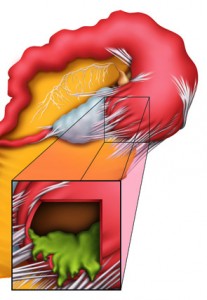
This hydrosalpinx caused infertility and STIs can both physically impede the movement of an egg or sperm cell.
Again, if a tube is totally blocked, fertilization will never occur. We probably see a pattern here, huh?
Fertilization within a partially blocked tube can cause an ectopic pregnancy. In this condition, the embryo will not survive, and the mother’s life and health are at risk by a child’s growth within her fallopian tube.
Now that you’ve learned some terms let’s talk about why the Wurn Technique is your best bet to heal infertility naturally.
Your Blocked Fallopian Tubes are like a garden hose.

It’s helpful to use an analogy to understand how adhesions can affect female fertility and how releasing adhesions non-surgically can improve a woman’s health and fertility. Imagine a garden hose that has fallen into disrepair in an overgrown garden that no longer functions to understand a blocked fallopian tube better. Weeds have grown inside the hose and kinked it from the outside. By gently detaching the weeds that have clogged or twisted the hose, and unkinking it, so it returns to its original state, the physical blockages have been removed, and water can successfully flow through the hose again.
Similarly, if a blocked fallopian tube can be “unblocked” by gently detaching adhesions and micro-adhesions with manual physical therapy, the passageway for the sperm, egg, and fertilized embryo can be effectively cleared. The name of the Clear Passage restorative physical therapy program grew from its success in opening blocked fallopian tubes.
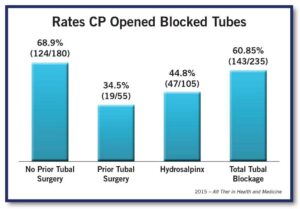
What other treatment options does a woman with a blocked fallopian tube have to restore her fertility and increase her odds of conception?
Traditionally, a woman with blocked fallopian tubes has had just a few options when it comes to treatment.
Balloon Tuboplasty for Infertility Pros and Cons
Pros
- If a tube is blocked proximally (close to the uterus), a surgeon can try to open it with minimally invasive surgery such as a balloon tuboplasty, which can stretch the tube open.
Cons
- Surgery causes more blockage in the long run due to scarring.
Tubes blocked in the middle or near the ovary are often considered beyond surgical repair. In these cases, reproductive specialists may suggest removing the blocked tubes and proceeding to IVF.

In-Vitro Fertilization for Infertility Pros and Cons
Pros
- IVF treatment is designed to bypass blocked fallopian tubes and implant a fertilized embryo directly into the uterus.
Cons
- IVF treatments are costly and carry success rates that are well under 30%, according to the Centers for Disease Control.
- Thus, IVF can cause significant physical and psychological stress for the woman and her partner.
- Each IVF attempt has a chance to work for only one cycle. If a woman does not conceive after a round of IVF, she must repeat the cycle.
- In addition, the decision to surgically remove a woman’s blocked fallopian tubes and pursue IVF is irreversible.
- Once removed, a woman no longer has the option of having a natural pregnancy in the future.
What are the benefits of a natural approach to infertility treatment?
Many women have pursued this non-invasive, non-surgical method of manual physical therapy, seeking a more natural approach to treating a blocked fallopian tube. This hands-on therapy can gently and gradually reduce the impact of adhesions, freeing them from their grip within or around a fallopian tube.
Because the therapy addresses the pituitary and ovaries (as well as the fallopian tubes), this manual physical therapy has been shown to improve the function of the reproductive organs, including the critical hormonal feedback loops that contribute to ovulation.
This alternative method is not only safe, but it is also 100% natural, incorporating no hormones or other medications, no medical procedures, and no electrical stimulation.
At Clear Passage, the specific type of manual physical therapy employed is known as the Wurn Technique. It is supported by nearly two decades of experience and high-quality clinical research.
What is the Wurn Technique?
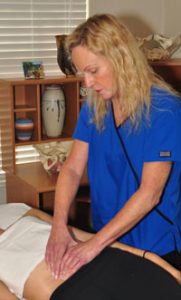
The Wurn Technique is a manual (hands-on) physical therapy method co-developed by Larry and Belinda Wurn. It is a patient-centered method supported by scientific data and cited in many academic research papers. The Wurn Technique uses manual physical therapy to help decrease pain from adhesions, improve organ mobility, and even improve hormonal function.
A certified physical therapist conducts a comprehensive evaluation during a Clear Passage therapy program, focusing on each woman’s unique health history and goals. Then, the practitioners use manual therapy to release adhesions that are both superficial and deep, addressing adhesions and micro-adhesions that have formed and may be impacting reproductive function.
By physically manipulating the structures of the abdominal and pelvic regions, the therapists detach the tiny collagenous fibers that comprise adhesions from each other and the underlying structures.
Doing so has been shown to open blocked fallopian tubes and decrease the straight-jacket squeezing at the uterus and other reproductive systems. In a sense, it is like ‘going back in time; as the therapists at Clear Passage detach the adhesions that formed years or even decades ago.
The organs can regain their former structure and function when freed of these internal bonds, thereby improving a woman’s fertility.
Simply put, no fallopian blockage = fertility!
Isn’t the Wurn technique a massage? How can it possibly open tubes or improve a woman’s fertility?
“Calling this work a massage is like calling the Space Shuttle a plane,” says gynecologist-surgeon Richard King, M.D. “I have witnessed results that rival anything we can do as surgeons. This therapy is remarkable because it avoids the internal scarring that can occur and re-block tubes after surgical attempts to repair blockage.”
The users of the Wurn Technique, the Clear Passage therapists, have studied the structure and nature of adhesions extensively over the last 30+ years. Their goal is to clear adhesions from reproductive structures. Their focus is to shear or detach the fibers that comprise adhesions from each other and the underlying structure through deep tissue manual therapy.
In doing so, the delicate organs of the reproductive system become freed of their adhesive bonds and are thus able to move and function as they did before being glued down by internal scars.
What does clinical research say about the Wurn Technique?
Research about the successfulness of the Wurn Technique concerning female infertility was first published in 2004, and since then, many other studies have found similar positive results. The cardinal research done in 2004 found that manual physical therapy sessions that targeted adhesions in the pelvis resulted in 71.4% of patients diagnosed with infertility achieving a natural pregnancy within one year, one-third of whom were able to go on to have subsequent pregnancies without further treatments.
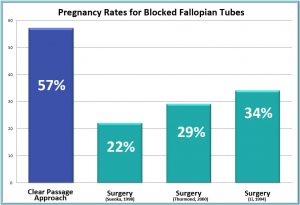
Beyond just improvement of fertility in women with tubal adhesions, researchers have also found that women who suffer from a hydrosalpinx (or swollen tube), rather than exclusive adhesions, can also benefit from a manual physical therapy technique. Researchers have also found that patients who struggle with other women’s health conditions, such as pain with sexual intercourse (dyspareunia) and painful menstrual periods (dysmenorrhea), can benefit from manual physical therapy.
An oral presentation by Clear Passage staff to physicians at the American Society of Reproductive Medicine addressed the main side effects of the Wurn Technique: increased desire, arousal, lubrication, orgasm and satisfaction, and decreased pain with intercourse.
The Wurn Technique’s growing scientific backing makes it one of the most formidable alternative therapies when it comes to helping women who suffer from tubal factor infertility. In a 10-year study of infertile women, the Wurn Technique achieved a pregnancy after therapy opened their tubes. This is especially significant when considering that the base pregnancy rate of IVF is around 30 percent for women ages 35 to 37 – a rate that decreases further with age.
How is the effectiveness of the Wurn Technique and Clear Passage therapy measured?
Clinicians specializing in helping women with infertility use an imaging method called hysterosalpingography (HSG) to visualize whether or not a woman has patent (unblocked) fallopian tubes. The test uses x-ray technology and a specialized dye to demonstrate flow through a tube.
A hysterosalpingogram can also demonstrate whether a woman’s fallopian tube has become unblocked after a particular treatment program.

Astoundingly, researchers in peer-reviewed studies have shown this manual physical therapy to open fallopian tubes that had been completely blocked. Restoring patency to a previously blocked fallopian tube without surgery is a remarkable achievement, and studies show it can help many women achieve a natural pregnancy through non-invasive means. This non-surgical approach may be preferable for many women, as researchers in top medical journals have not demonstrated the universal effectiveness of surgery for tubal factor infertility.
What has recent research shown about the Clear Passage technique?
Clinicians have implemented the Wurn Technique for nearly two decades. As time has marched forward, and more and more women struggling with infertility have sought non-invasive, non-surgical approaches to management, the Wurn Technique and Clear Passage natural treatment approaches have gained more excellent scientific backing. With the Clear Passage technique, many women can have successful pregnancies that go to full term after a single treatment course. Many find they can also have successful subsequent pregnancies without any other therapy. Recently, researchers worldwide have been studying the impact of the Clear Passage method.
A recent analysis in 2022 published in the Turkish Journal of Physiotherapy and Rehabilitation provided an in-depth and complementary analysis of the Clear Passage Approach and Wurn Technique. They noted that the Wurn Technique effectively treated infertility caused by blocked fallopian tubes. It was also effective for women who suffer from other health conditions—such as endometriosis and hormonal disturbances.
What else has scientific evidence shown about the benefits of manual physical therapy?
The positive impact of manual physical therapy on reducing adhesions extends beyond the condition of female tubal factor infertility. Several recent peer-reviewed studies have found that manual physical therapy techniques can help with a wide range of medical conditions. Uniquely, more researchers have shown CP therapy to be an effective way to reduce the occurrence of life-threatening small bowel obstructions and chronic pain. In fact, according to another research published in 2018 in the World Journal of Gastroenterology, more than one hundred patients who received the Clear Passage manual physical therapy approach reported a significantly lower recurrence of small bowel obstructions. The treatment groups had fewer symptoms from their previous obstructions and improved overall quality of life compared to subjects in the control group.
Manual physical therapy has also been shown to effectively prevent the development of adhesions in the first place after a patient has undergone surgery.
Does research show that the Wurn Technique can be used to enhance or augment other types of infertility treatment?
The Wurn Technique can help completely restore the function and viability of a blocked fallopian tube, allowing a woman to achieve a natural pregnancy successfully. However, even in women who are dedicated to pursuing conception through other means, such as IVF, the Wurn Technique can help support their goals and increase their pregnancy success rates. Clinicians have found that combining manual physical therapy techniques with a traditional IVF treatment plan can increase a woman’s likelihood of successfully conceiving. Research has shown that undergoing this manual therapy treatment within 15 months before an IVF embryo transfer can increase a woman’s pregnancy success rate by 50 percent.
What makes the Wurn Technique and Clear Passage program unique?
The Clear Passage program differentiates itself through its non-invasive, hands-on approach to female infertility. Therapists who practice the Clear Passage approach are certified through a rigorous training program and are selected based on their years of experience. A therapist’s ability to correctly and competently carry out manual physical therapy to improve fertility is tested and validated rigorously during the training period.
Clear Passage practitioners are also dedicated to carrying out clinical research to quantify and demonstrate the continued effectiveness of their manual therapy approach. Their strong commitment is illustrated by their repeated publication in some of the world’s top medical journals. Additionally, leading medical institutions like Harvard, Columbia, and Northwestern University endorse the Clear Passage technique.
The Clear Passage Approach is also unique in how it views the therapist-patient interaction. Rather than using a top-down treatment approach, Clear Passage practitioners encourage their patients to be involved in their healthcare decision-making and be part of the therapy team. After all, a patient has much more extensive knowledge about her body and health history than any treating therapist. Doctors can harness this expert personal knowledge to improve her treatment plans and outcomes.
What is the structure of the Clear Passage treatment program?
Clear Passage offers a free pre-therapy consultation for women interested in pursuing this manual physical therapy as an infertility treatment. This program can help women and support people learn more about the program and ask questions about their particular medical situation.
One of the key benefits of the Clear Passage program is its precise structure. The typical Clear Passage regimen requires 20 hours of manual therapy. This therapy is typically spread throughout a five-day session, four hours a day, with most sessions fitting squarely within one business week.
This condensed treatment plan is beneficial for those who have hectic schedules or travel to the Clear Passage clinic from out of town or out of the country.
What are the financing options available for the Clear Passage treatment program?
Today, the cost of a Clear Passage treatment program for infertility ranges from $6,500 to $7,500. While this is a financially significant investment, it pales compared to other infertility treatment options on the market. Many financing options are available for women interested in pursuing Clear Passage therapy.
For example, Clear Passage clinics offer a financing option with Care Credit. Financing through Medicare and Medicaid is currently not supported—however, the Clear Passage team is continuously working to improve financing channels for patients.
The Clear Passage Bottom Line
Female infertility can be a devastating condition for women who desire to achieve a natural pregnancy. However, through Clear Passage, women struggling with tubal factor infertility and other women’s health conditions have a natural, evidence-backed treatment option that does not involve drugs, needles, or costly or irreversible procedures.
Clear Passage therapists are highly skilled and provide their patients with a scientific, patient-centric, hands-on therapy approach. They are dedicated to achieving positive results for each patient and to contributing to worldwide research efforts that quantify these efforts.
The dedicated team of therapists, researchers, advisors, and support staff at Clear Passage apply their excellence daily, and they are continuously learning to deliver superior care to their patients.
Make the right decisions for your dreams today!
To learn more, request a consultation today.
References:
Infertility Workup for the Women’s Health Specialist.
Role of tubal surgery in the era of assisted reproductive technology: a committee opinion.
Sexually Transmitted Diseases.
Treating Hydrosalpinx with a Manual Pelvic Physical Therapy.
Treating fallopian tube occlusion with a manual pelvic physical therapy.
Female Age-Related Fertility Decline.
Surgery for tubal infertility.
Manual Therapy and Infertility: Review of Evidence.
Attenuation of postoperative adhesions using a modeled manual therapy.
Related Content:
Diet
Ectopic Pregnancy
Sexual Dysfunction
General Info
- Book Chapters: Overcome Infertility and Pain, Naturally
- How to Treat Infertility Naturally
- Everything about the Best Natural Infertility Treatments
- Fertility Treatment – The Natural Way
- Infertility Risk Factors
- What Causes Infertility in Women? (Infographic)
- [Infographic] Common Risk Factors for Infertility
- How Does Tubal Surgery Compare to Other Infertility Treatments?
- Published Pregnancy Rates With and Without Clear Passage®
- Budgets and Numbers and Bills, Oh My! – Paying for Infertility Treatment
- English Surrogacy
- Guide Through Infertility: From Diagnosis to Treatment
- Spirituality Can Help Women with Premature Ovarian Failure
- For Healthcare Providers: Women’s Health Issues and Female Infertility
Infertility: Adhesions | Blocked Fallopian Tubes | Diet | Ectopic Pregnancy | Endometriosis | FSH | Hydrosalpinx | Hysterosalpingography | Female Infertility | IVF Conditions | Ovarian Failure | PCOS | Secondary Infertility | Unexplained Fertility

















